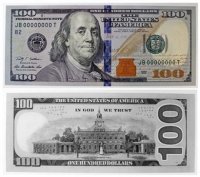
New $100 note aims to deter counterfeiters
(Reuters) - A newly designed $100 note aims to thwart counterfeiters with advanced security features, top U.S. Treasury and Federal Reserve officials said on Wednesday.
The "new Benjamins" to be released in February 2011 retain the traditional look of the U.S. currency, with Benjamin Franklin's portrait. They aim to foil counterfeiters with difficult and costly to reproduce features such as a blue three-dimensional security ribbon with alternating images of bells and the number 100 that move and change as the viewing angle is tilted.
The new notes, which cost slightly more to produce, also feature a bell image inside a picture of an inkwell that changes from copper to green when tilted, as well as a large "100" that does the same.
"As with previous U.S. currency redesigns, this note incorporates the best technology available to ensure we're staying ahead of counterfeiters," U.S. Treasury Secretary Timothy Geithner said at a Treasury Department unveiling ceremony. "Welcome to the new Benjamins."
The $100 note is the most often counterfeited denomination of U.S. currency outside the United States due to its broad circulation overseas. It is the highest-denominated note issued by the Federal Reserve.
The approximately 6.5 billion older design $100s already in circulation will remain legal tender after the new notes are released next year.
BEATING THE SUPERNOTE
In recent years, U.S. officials have been trying to combat the continued production of extremely high-quality counterfeit $100 notes they say are produced in North Korea, dubbed the "supernote," which are undetectable to nearly all but the most sophisticated currency experts.
The U.S. Secret Service, the agency charged with policing the cash dollar's integrity, maintains that less than 1/100th of one percent of the $890 billion in physical U.S. currency in circulation is counterfeit. But Secret Service officials say they still encounter supernotes and other highly sophisticated fakes from overseas.
In the United States, the $20 note is the most frequently counterfeited denomination.
The new Benjamins have been in development since 2003. The blue security ribbon is woven into the note's fabric -- not printed on. Another security strip, visible to the left of Franklin's head when the note is held up to light, is embedded into the fabric. Like the old note, the new one has a watermark of Franklin's portrait, also visible when held up to light.
The old notes will be destroyed and replaced as they pass through the Federal Reserve system.
John Large, special agent in charge of the Secret Service's criminal investigations division, said the features were designed to make it easy for merchants and consumers to verify the $100 note's authenticity with a quick examination.
"The best defense against counterfeiters we have is an educated public that can easily authenticate the new $100 note," Lange said.
Federal Reserve Chairman Ben Bernanke said U.S. officials will work to educate people around the world about the new design. Unlike in the past, when most cash dollars were held domestically, as many as two thirds of Federal Reserve notes now in circulation are outside the United States, he added.
(Reporting by David Lawder; Editing by Andrew Hay)





 Hassan Khamis
Hassan Khamis
